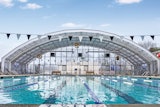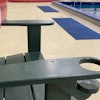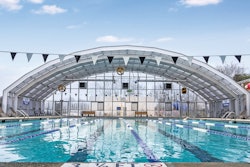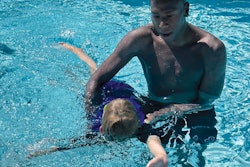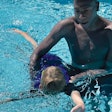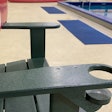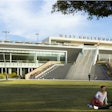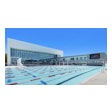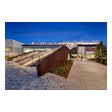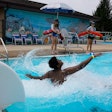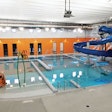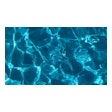Efficient humidity control safeguards not only the comfort and health of an athletic facility's occupants, but the well-being of the building itself.
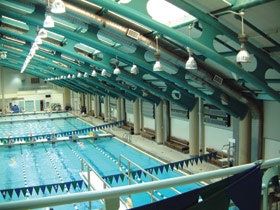


Water droplets inching down natatorium windowpanes. Fog blanketing an arena's ice sheet. These are telltale signs of poor air handling and insufficient dehumidification. Unless promptly and adequately addressed, such mechanical deficiencies may affect not only the comfort and health of occupants within each venue type, but the building's well-being, too.
Natatoriums present a particular climate-control challenge in that the air within them is not only humid, it's laden with corrosive chemicals that have evaporated from the pool surface. "There have been situations where the corrosion to the structure gets so bad that the ceiling collapses," says Jim Voitel, director of marketing for PoolPak International, a York, Pa.-based indoor pool dehumidification company. "That's the worst kind of failure."
Structural corrosion also represents a worst-case scenario within ice rinks. More common, though, are condensation issues that compromise the quality and safety of the ice surface. Says Michael Hayes, sales engineer for Munters Corp., a dehumidification company with manufacturing facilities in Selma, Texas, "I was at a facility that had significant structural corrosion, with frequent incidences of fog, as well as condensation that built ice mounds on a daily basis. It was not corrected, and the facility was shut down due to low revenue."
Dehumidification experts agree that collapses both structural and financial can be avoided if careful consideration is given to the dehumidification process - and the earlier, the better. "It all starts with the design of the facility," says James Hogan, product development engineer for Dectron, a Montreal-based dehumidification systems manufacturer. "The key for operators is education. They need to understand that there are no shortcuts, and hold their architects, engineers and installers to established recommendations."
To that end, building enclosures must be sufficiently airtight for the specified HVAC system to operate effectively. As Vince Cammalleri, associate principal at Simpson Gumpertz & Heger (SGH), a structural engineering firm headquartered in Waltham, Mass., notes, "If you have a leaky building, you'll have a difficult time conditioning the air no matter how good the mechanical system is."
Leaks are especially troubling in natatorium settings, where mitigating the spread of corrosive water vapor into adjacent spaces is critical. This unwanted infiltration can happen in two ways. One is vapor diffusion, whereby water vapor molecules migrate from an area of high vapor pressure to one of lower pressure through the pore structure of the materials between the two spaces - some materials (gypsum, stone, concrete) being more permeable than others (glass, steel, plywood). The other is airflow, which, according to SGH staff consultant Ned Lyon, "can carry hundreds of times more moisture than diffusion."
In either case, barriers must be specified within walls and ceilings to prevent vapor escape. Vapor barriers often take the form of sheet goods such as polyethylene or foil, while more common building materials such as plywood and gypsum may sufficiently block airflow, provided that all joints, intersections of walls and ceilings, and window and door punch-outs are taped or sealed to form a continuous gap-free system. Because air leakage exacerbates vapor escape more than does diffusion, Lyon emphasizes the importance of air barriers separating interior spaces, even if vapor barriers are used only on exterior walls. He recalls one multipurpose facility where operators had no clue that water vapor was escaping their natatorium, even though the evidence was right above them. "They were complaining to me about the skylights leaking in their adjacent gymnasium," Lyon says. "Their skylights don't leak. Their skylights condense in the wintertime because warm humid air is spilling out of the natatorium."
Adds Cammalleri, "Whenever we deal with these problems, we attack the air barrier issue much more thoroughly than we do vapor barriers, because plugging up the holes is what's going to give you the best result for the dollar."
Creating an airtight space facilitates another critical means of retarding vapor migration: negative air pressure. As much as 30 percent of a natatorium's air is exhausted by fan to the outdoors, to be replaced ideally by just enough outside ventilation air and HVAC-treated return air to maintain negative pressure within the pool area. A noticeable breeze into the natatorium upon opening an exit door is indication that the space exhibits the minimum amount of negative pressure needed. Conversely, a noticeable smell of chloramines in the surrounding air as one approaches a natatorium entrance indicates that negative pressure is insufficient or, worse, nonexistent. In that case, air laden with corrosive chemicals may be leaking into adjacent spaces that are not equipped to handle it.
That is not to underestimate the importance of vapor barriers, particularly in the ceiling and exterior walls, where mold contamination and structural degradation are possible. All too common is the sight of ice forming on exterior wall surfaces of a natatorium in wintertime, a phenomenon that can lead to spalling of the brick face. "If you get the room under control in terms of humidity, it will slow down the process," says Tony Giuffre, an engineer at Dehumidifier Corp. of America in Cedarburg, Wis. "But unless you have the proper vapor barriers and room construction to keep the moisture in the space, you're going to have a problem, no matter what."
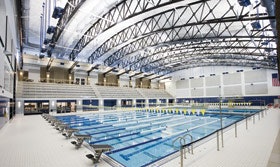
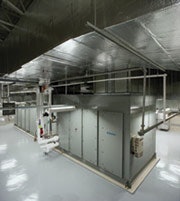
Once the volume of air is sufficiently contained, air quality is more easily controlled. Again, natatoriums present a particular challenge in that pools, depending on number and size, are putting as much as 500 pounds of water into the air via evaporation every hour. That amount can easily double in a water park setting. "The pool is essentially nothing more than a low-pressure tea kettle," Voitel says. "The warmer the water gets, the more the vapor pressure increases, and the water molecules leap off the pool surface and saturate the air above. If you think about the Gulf of Mexico, it pumps a lot of water vapor into the sky. Well, the pool is doing the same thing in an enclosed environment."
Dehumidification, at least in the cold-coil systems commonly used in natatorium settings, essentially forces condensation to occur where it can best be managed (inside the dehumidifier), thus limiting its unsightly and potentially damaging occurrence elsewhere in the space (on windows and rafters). Because the temperature of the refrigerated coil is lower than the dew point of the surrounding air, water is pulled out of the air and onto the coil as condensate. In the process, heat is released, recovered by the dehumidifier and returned to the air space minus the moisture.
To make this all possible, ideal climatic parameters must be adhered to regarding water temperature (usually between 78 and 84 degrees), air temperature (usually two degrees warmer than the water, to help quell evaporation) and relative humidity (between 50 and 60 percent is the typical comfort range for natatorium occupants). Dehumidification becomes critical to controlling the latter. If the air is too dry, water on swimmers' skin evaporates so fast that they feel chilled; too humid, and the air becomes oppressive to swimmers and spectators alike, and potentially damaging to building components. "If you let the relative humidity creep up, the air becomes uncomfortable," Voitel says. "And as the relative humidity creeps up, it starts to raise dew points, which means surfaces then tend to condense at much higher thresholds than they normally would."
An appropriate mix of air also is required to enhance air quality. Ventilation air - that is, air pulled into the natatorium from the outside - is a must to remove chloramines. But, depending on the time of year and geographic location, ventilation air may introduce to the pool space an additional 50 pounds or more of outside moisture per hour.
Current recommendations of the American Society of Heating, Refrigeration and Air-Conditioning Engineers call for .48 cubic feet of ventilation air per minute per square foot of pool and deck area. Spectator galleries in larger natatoriums must be accounted for, too. The same goes for ice facilities (though in that application ventilation is used primarily to dilute fuel exhaust from ice-resurfacing machines), making it cost-prohibitive for some rinks to remain open during the summer months.
Interior conditions within a natatorium - perhaps more so than an ice facility - will dictate how the air-handling system responds. "The occupancy clearly determines the amount of water vapor generation," Voitel says. "If you have a lot of activity in a pool - the water surface is being churned up, people are running around, the deck is wet - the de-humidification load goes up." (See "Air Apparent," Oct. 2004, p. 85.)
Dehumidification sensors can measure the humidity of return air while a microprocessor turns compressors on and off or opens and closes dampers accordingly. A sensor also monitors exterior conditions, and may instruct the equipment to dehumidify interior spaces using only outside ventilation air (provided it's sufficiently dry) by opening the dampers and shutting down the compressors completely. Dry wintertime conditions in certain locales can be put to particularly good use by ice facility operators, who may be able to dehumidify their interiors using ventilation air alone for extended periods.
What constitutes ideal climatic conditions within ice facilities may vary, however. "It's a balancing act," Hayes says. "Lower temperature and humidity mean lower heat loads on the ice, but they also increase the cost in terms of air conditioning, and in the end it may be too cold for skaters or spectators."
An ice arena air temperature of 55 degrees is typical, Hayes adds, while the temperature of the ice itself should range between 23 degrees (for ice hockey) and 27 degrees (for figure skating). But forcing moist air to condense at a dew point bottoming out around 35 degrees becomes tricky for a refrigerated dehumidification unit - its cold coil eventually becoming so cold that liquid condensate gives way to frost, at which point system efficiency drops precipitously. To combat this problem, the cold coil is paired with a heating coil to periodically defrost the unit (three five-minute defrost cycles may be necessary every hour, but with no noticeable change to air conditions in the arena), or two cold coils are specified to alternately handle dehumidification cycles.
A third means of dealing with the extremely low dewpoints required of ice facilities is by employing a desiccant dehumidification system, which uses chemical drying agents in place of a refrigerated coil to pull moisture out of the air. "The desiccant process can remove water from air without cooling it," Hayes says. "This allows us to eliminate the freezing issues." Costlier to purchase and operate, desiccant units are favored primarily by large professional arenas. Says Harry Milliken, northeast regional sales manager for Germantown, Wis.-based dehumidifier manufacturer Desert Aire Corp., "If you're talking about the mom-and-pop, hometown rinks, a lot of them are opting for the refrigeration-based, low-temperature dehumidification units to control the fog on the ice - not necessarily the whole building."
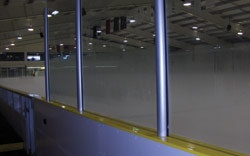
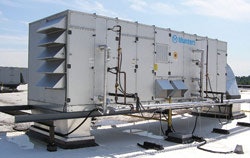

Year-round operation of natatoriums and arenas would be foolhardy without today's dehumidification technology. But could an indoor pool be operated at all without it? Sure, says Hogan. "You can bring in dry outside air, heat it up to room temperature, put it in the room and then exhaust it. That will do the dehumidification, so long as it isn't summer and you have a big wheelbarrow full of money," he says. "Not only are you having to heat the new air, but you're also having to heat the pool because there's no way to recover the heat that's lost from the pool to evaporation. So if you have any constraints on your budget, or if you're at all thinking about the environment, you wouldn't do that. It really all comes down to money. Can you afford to operate a commercial pool or not?"
Those owners and operators who can are given this piece of parting advice from Milliken: "Set the temperature and humidity to what you want, flip the switch on and walk away. Don't try to cycle the system on and off during occupied and unoccupied times. The only thing that operators should be worried about is some quarterly maintenance to check and make sure the equipment is operating properly." Adds Voitel, "The primary function of a pool operator, in my opinion, is to maintain proper pool water chemistry, because there is no substitute for that. Poor pool water chemistry will destroy everything."
Still, it doesn't hurt to have a basic sense of what a facility's dehumidification system is trying to achieve. "All these systems are a little bit different, and you have to put some thought into all the subsystems," says Giuffre. "You have to consider not only the dehumidification, but also the room cooling - a lot of times you have a lot of glass, and a lot of sensible cooling that has to be done. And you have to consider the pool-heating and ventilation systems, and how these all have to work together. Somebody along the line has to understand how the whole system works."
Above all, operators must learn to recognize the signs of humidity run amok in their facilities and react accordingly. "Operators see condensation or mold in their facility but may not see an immediate consequence," Hayes says. "They may even assume that it will go away on its own and never cause significant problems. Then sometime down the road, they start to realize that humidity is causing significant health and safety issues, jeopardizing their building structure and even affecting revenue. They may have thought they could not afford to prevent or solve these problems, but in the end - and sometimes it's too late - they realize that they cannot afford to not solve them."

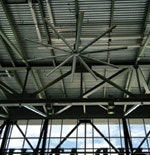
"It has 94-foot ceilings and air-handling equipment that was designed to push that air down," says Heather Henley, public relations specialist for Lexington, Ky.-based commercial ceiling fan manufacturer Big Ass Fans. "When they were having night events in the winter, they were having to set their air-handling equipment to 115 degrees, and it would still only be about 60 degrees on the floor."
Big Ass Fans retrofitted the 366,000-square-foot atrium with three ceiling fans, each measuring 24 feet in diameter. "Now, they actually set it to 72 degrees and it's 72 degrees on the floor," Henley says. "They're still using that air-handling equipment, but they're not having to max it out."
Treating the air within athletic venues is one thing. Getting it to where it needs to go is quite another. Sometimes ductwork can only do so much. In a natatorium, for instance, it is essential that the air-handling system be able to throw heated and dehumidified air directly onto windows, doors and skylights, thus ensuring their surface temperatures remain above the dew point to prevent condensation. Meanwhile, an undesirable blanket of chloramines may be stagnating over the pool surface. "You need air movement," says Jim Voitel, marketing director for indoor pool dehumidification manufacturer PoolPak International, who reports seeing fan applications in both natatoriums and water parks. "There's still no substitute for taking the air and treating it, but that's a good compromise."
Adds James Hogan, product development engineer for dehumidification manufacturer Dectron, "The key to it is that we have to know in advance about a fan when we're sizing the dehumidification unit. The reason is that the rate of evaporation from the pool is governed by several things, including pool and room temperature, but also by the speed of the air over the surface of the water. We just need to know what that's going to be."
Ductwork itself has evolved over the past 25 years to be more efficient at distributing treated air. Fabric ducts, in particular, have brought several air-handling advantages to high-bay applications. The fire-retardant ducts are naturally resistant to corrosion in the pool environment and can be specified with a factory-applied antimicrobial treatment to help prevent mold growth. They come either with porous fabrics (allowing air to escape throughout the run) or impervious weaves perforated with any number of openings as small as the diameter of a pencil or as large as five inches. "A run of metal duct with two diffusers has a spot here and a spot there where the air comes out and that's it, so you're going to get hot and cold spots in between," says Jeff Klopfenstein, sales engineer for Dubuque, Iowa-based DuctSox Corp., which manufactures fabric ducts up to 84 inches in diameter. "With the porous or nonporous fabrics, we can distribute the air continuously along the whole length of fabric."
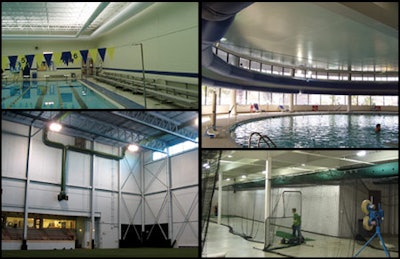
Moreover, fabric's malleable nature makes custom air-handling layouts a breeze. "We've done some pretty dramatic things in water parks, where we've had to follow the lazy river throughout," Klopfenstein says.
Fabric ductwork is also seen as a green air-handling alternative. "For one of the school gymnasiums that we worked on, we delivered the fabric ductwork in the back of a Ford Explorer," says Klopfenstein, a LEED® accredited professional. "If we had done that project in metal, it would have been a flatbed trailer loaded to the gills. So there's a significant difference in terms of the fossil fuel used for transportation."
Ceiling fans are environmentally friendly, too. Unlike residential units, Big Ass Fans don't feature seasonal forward and reverse modes, but they can be set to run at variable speeds - slower in winter, faster in summer. "There's a year-round benefit," Henley says. "In the summer, of course, you get the cooling effect, because of the quicker evaporative cooling of sweat off the skin. That can make a person feel about 17 degrees cooler. Because of that, you're not running your HVAC as hard. For every degree you raise or lower the thermostat, you're saving about three to five percent on energy. You save energy, and people stay more comfortable."










